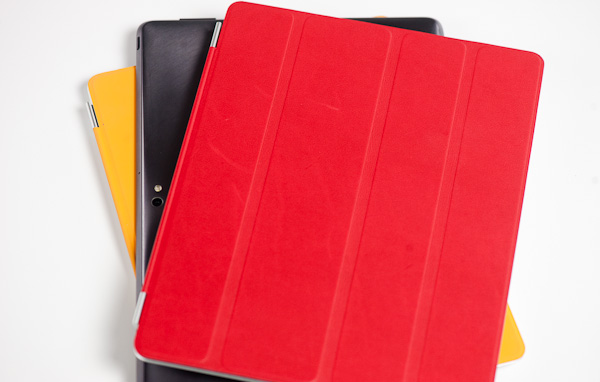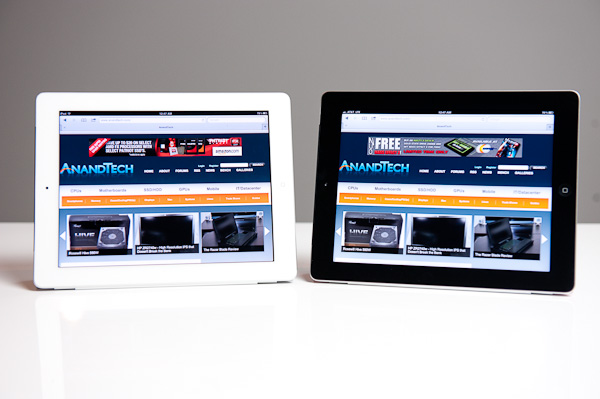The Apple iPad Review (2012)
by Vivek Gowri & Anand Lal Shimpi on March 28, 2012 3:14 PM ESTSince Apple launched the first iPad two years ago, the tablet market has evolved rapidly. While slate tablets were nothing new, the original iPad was the first serious tablet to be built around smartphone components and a user interface designed specifically for touchscreen input. The hardware was enough to run the OS smoothly while maintaining good battery life, the thin and light form factor lent itself to easy portability, and the touch-based user experience was miles better than earlier devices based on desktop operating systems.
We take it for granted now, but this was all news back in 2010, and the iPad was practically in a category of its own, with no real competitors to speak of. After Apple started shipping the iPad, the segment basically exploded—we had Google jump in with Honeycomb, HP got into it (and then out of it) with webOS, RIM had a go with the PlayBook, Amazon pushed the Kindle line into the tablet space, and Microsoft created its next release of Windows with tablets in mind. Along the way, Apple updated the iPad, both on the software side with multitasking, a new notifications system, and a myriad of UI updates, as well as launching second generation iPad hardware. The iPad 2 was a comprehensive update, bringing a dual core processor, unrivaled graphics performance, cameras fore and aft, and a ground up redesign that brought a thinner and lighter form factor.
The iPad 2 was a significant improvement over the original—faster, more portable, and generally a far more polished device. Not that it was perfect: iOS 4 still had issues with smooth multitasking and an archaic notifications system, the cameras were mediocre, and the XGA display, while a great quality panel, didn’t have the kind of pixel density expected of a premium mobile device. The iPad 2 hit market around the same time as Honeycomb (in Motorola’s Xoom) early last year, and at first Apple still held a major edge in terms of hardware. As more impressive Honeycomb devices like Samsung’s Galaxy Tab 10.1 and the ASUS Transformer Prime were launched, along with Ice Cream Sandwich looming on the horizon, Android became a much more viable tablet alternative to iOS. And with Microsoft planning for a major push later this year for ARM-based Windows 8 tablets centered around the Metro UI, Apple has never faced such stiff competition in the tablet space. Which brings us to the third generation of iPad hardware.
It has a display resolution that dwarfs most high-end desktop displays. The panel also puts a real emphasis on quality, not just resolution. For a computing device targeted squarely at the consumer market, both of these things are rarities.
Its SoC is the absolute largest ever squeezed into an ARM based tablet. The chip itself is even bigger than what you find in most mainstream notebooks. It’s expensive, it puts out a ton of heat and it offers a tremendous GPU performance advantage over anything else in its class.
And it has a battery that’s larger than what ships in the current crop of similarly sized ultraportables and Ultrabooks.
The new iPad doesn’t significantly change the tablet usage paradigm, but it does put all previous attempts at building hardware in this space to shame. It’s the sort of no holds barred, performance at any expense design that we’re used to seeing from enthusiast PC component vendors—but in a tablet...from Apple.
Welcome to the new iPad.












234 Comments
View All Comments
antef - Wednesday, March 28, 2012 - link
Yes it's nice, no one will argue that. But I don't see it as the huge advancement the authors indicate. Using it in the store it seemed fine, but honestly just walking right up to it, I wasn't even sure if I was using the new or old iPad. I had to go over to the iPad 2 to recognize the difference. And even then, after being back at the new iPad for a couple minutes, I completely forgot about it. If you are looking for pixels, sure, you'll notice. If you're just using your device and thinking about other things, probably not so much.PeteH - Wednesday, March 28, 2012 - link
Eh, I think it depends on what application you use the iPad for. Web browsing and Tweeting? You're probably right, you wouldn't notice the difference in displays. But if you use it to view images I could see it being a big deal.zorxd - Wednesday, March 28, 2012 - link
I am pretty sure extra resolution is more noticeable when reading text than when looking at imagesPeteH - Wednesday, March 28, 2012 - link
I didn't mean "notice" as in you couldn't tell the difference, just that the difference wouldn't be something that you would constantly be aware of if you were simply web browsing.If you were reading an e-book? Absolutely, but if that's your only use case I'd get a Kindle and save the money.
Regularly viewing quality images is something that can't be done on an e-ink reader, but for which the improved display would make a huge difference.
Sabresiberian - Thursday, March 29, 2012 - link
I would say this is a perfect example of why it's better to use "I"" statements than say "YOU won't notice, YOU won't care, there isn't that much difference" - those kinds of statements. "I didn't notice much of a difference, it wasn't a big change in MY experience. . .)Displays can very very personal in experience, and things that bug the heck out of me may not be a problem to someone else. For example, a pixel pitch of around .270mm is just too big for me, in a monitor, and it bugs me. Always.
Frame rates are a good example of something I'm not consciously aware of all the time, but I can sure tell the difference on some level, and some displays are more effected than others. There are extra factors in LCD screens that can make the problem worse for some of us - others don't notice so much, or it's just not a problem for them.
One thing I believe, is that as more people use really better screens, they'll understand more why some of us call for them every chance we get.
;)
darkcrayon - Wednesday, March 28, 2012 - link
I can *immediately* notice the difference in web browsing, which is primarily focused on reading text...tipoo - Wednesday, March 28, 2012 - link
I found it a noticeable difference, just not neuron melting like some reviews led me to think. For 100 or more less I'd still be plenty happy with an iPad 2, especially given the CPU and battery life performance are about the same.MobiusStrip - Thursday, March 29, 2012 - link
Unfortunately the iPad 2's camera is a disgrace. It should've had the iPhone 4 camera, which was already out by that time.repoman27 - Thursday, March 29, 2012 - link
The iPad 2 was also thinner than the iPhone 4. Now that it is the same width, it has the same camera. It's not really Apple's style to add thickness to a device just to support one feature that isn't heavily used anyway (tablets are not a very good form factor for a camera.)zanon - Wednesday, March 28, 2012 - link
Human vision varies significantly from person to person, as do use patterns for machines. Someone who is more near sighted or simply has better vision in general, and/or uses their system at a closer distance, may see a truly dramatic change. To take my personal example, I have excellent color vision and am also near sighted, and tend to hold my devices relatively close (or use glasses at my machine). I can see the pixels on the iPhone 4 screens (326 ppi) if I focus a bit, and for the older screens (or old iPads) they're massively pixelated to me (not that that made them useless). The High DPI screens are a night/day difference personally, making all types of reading in particular (be it on a terminal session, the web, PDF manuals, ebooks, or whatever) massively more functional (and everything else more beautiful).But that's just me, and is that awesome? No, it's kind of meh, I'd love it if I didn't need glasses to use my desktop without being hunched over the keyboard to drive. But understand that you'll see raves about the screen that are completely justified, just not for you. 20/20 vision puts the critical distance around 13" I think, but in the end everyone will need to take a look for themselves.